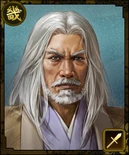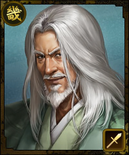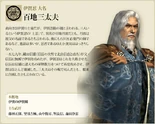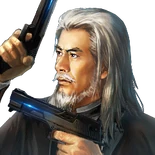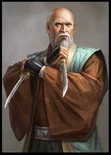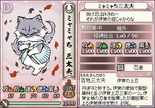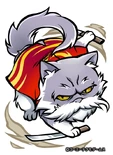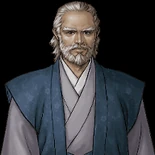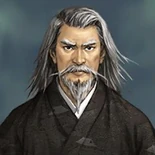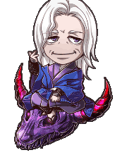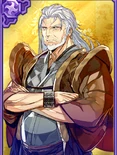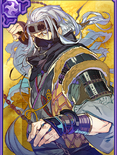| Sandayū Momochi | |
| Clan(s)/Alliance(s): | Momochi |
|---|---|
| Weapon Type: | Short sword
|
| Unit Type: | Ninja |
| Significant Battle(s): | |
| First Appearance: | Samurai Warriors 2 |
| Real name: | Momochi Tanba/Tamba
|
| Japanese name: | 百地丹波
|
| Born: | 1512
|
| Died: | 1581 (?)
|
| Real name unknown. Surname is alternatively pronounced as "Momoji". Also believed to have died in 1591 or 1595. | |
Sandayū Momochi (百地 三太夫, Momochi Sandayū) is a name commonly associated with one of the three Iga ninja leaders of the Warring States period. He is best known for defying Nobunaga during the riots in Iga. Edo period folklore tends to state that he taught Goemon and Kirigakure Saizō.
The Nobunaga no Yabou 201X poll for 4-star officers puts him in sixty-ninth place.
Role in Games
Samurai Warriors
100man-nin no Sengoku Musou establishes Sandayū as Hanzō and Goemon's mentor. He taught his pupils to kill their emotions for duty and objectifies them during their reunions. Out of his students, he favors Hanzō as his "finest creation". Sandayū cryptically warns his disciple to heed his principles in their conversations.
Goemon's character biography in the fourth title mentions that Sandayū tutored him. His allegedly strict teachings ostracized him from his disciple.
Kessen
Kessen III has him enter the narrative when he is hired by merchants and the shogun to oppose Nobunaga. The elderly Momochi is touted as a master shinobi and arrogantly relishes in his people's strengths. He possesses the strongest ninja equipment and units in the game. The player has the option to subjugate him and the Iga ninja in chapter 9. He defends his location with several ambushes and attacks with powerful ninja spells. If the player defeats him, he will perish in battle. Momochi otherwise disappears from the narrative after the chapter.
Nobunaga's Ambition
Throughout the series, Sandayū is often one of the strongest ninja units. He often has high War stats and ninja related officer abilities. In most titles, he is identified as the leader of all Iga ninja. His relationship with Goemon fluctuates with each title. Sphere of Influence states they are partners and Goemon is his second-in-command.
In the online adaption, Sandayū is the elderly leader of the Iga forces. He is a level 75 ninja commander who wields twin blades in battle and several NPC only spells.
Nobunyaga no Yabou has Sandayū act as Hanzō and Goemon's mentor in the Ninja no Gunzo scenario. He is the decisive and wise leader of all Iga ninja. When the Iga ninja incur Nobunyaga's wrath, Sandayū leads those in his village to revolt. He perishes in the heart of the conflict. Hanzō later investigates the ruins of his home to find a letter his mentor had left for him. It encourages his pupil to stay true to his lord in spite of whatever fate may befall their home.
Nobunaga no Yabou 201X has him appear in the Tensho Iga War event. Sandayū is recognized as a reigning chief of the Iga ninja; Yogiri and Yuugiri address him as "Chief" and Fujibayashi Nagatonokami is his lieutenant. He is a master of advance ninja spells, which he uses to subdue UMA within his home territory. At Hanzō's recommendation, Sandayū calls for allies near and far to join forces with Nobunaga in Iga's defense. He personally fights in the front lines at Fujiyama Castle and Heiraku Temple.
Voice Actors
- Bob Papenbrook - Kessen III (English-uncredited)
- Yasuhiko Kawazu - Kessen III (Japanese)
Quotes
- "Nobunaga, I will defeat you with the ways of old!"
- ~~Kessen III
Historical Information
Momochi Sandayū was Momochi Seiemon's son and the presiding lord to a small clan. Historically, his true name has not been verified. Sandayū is a fictional invention of the Edo period and is a distortion of a term for "clan elder" (三太, daifu). The name may have also been given to his grandson rather than the Momochi leader in question. Tanba or Tamba is either argued to be his government rank or a division of the Iga ninja to distinguish himself from the other elite ninja families, the Fujibayashi and the Hattori. Iranki dubs him Tango (丹後) over Tanba/Tamba. His given name may have been Yasumitsu or Masanishi.
Ninja history in general tends to be recorded oral legends, so it's difficult to verify the authenticity of his early history. According to the tales, Sandayū was known as a shinobi amongst shinobi. He was silent and emotionless: a true shadow without form. He reputedly never showed his face to others. Tales are divided on whether Sandayū was an impossibly skilled elite or a cowardly lower classed ninja. One legend states that Sandayū was never one person but rather three elite ninja who would flawlessly impersonate one another when deemed necessary. Most legends tend to favor his remarkable intelligence and state that he was a spy famed and valued for his reliability.
Whatever the case, Oda Nobukatsu invaded Iga in 1578 to expand his influence. He was initially successful until he was intercepted by the Iga rebels or ninja a year later. The defenders held the geographical advantage against Nobukatsu and gradually reclaimed their lost territory. According to the Iranki, Sandayū was among the defenders. He led two or three hundred defenders to arms, setting up various artillery barricades along a high mountain path. Oda retainer Tsuke Saburōzaemon accompanied Nobukatsu into their barricade with an army of 1,500. He and his men lost their lives, and Nobukatsu barely fled with his life. Nobunaga was outraged by his son's humiliation and wrote in a letter, "...[I am] tempted to break family ties with him".
In 1581 Nobunaga personally led an army of 40,000 with six generals to eradicate Iga residents. Historians argue that Nobunaga may have led the assault primarily to avenge his stained family honor rather than the personal grudge often stated in legends. Sandayū was noted to be present around the end of the conflict and led 1,600 or so tired Iga residents (either common men and women or rebel ninja) within Kashiwara Castle. He reputedly held a strong defense against the castle siege. From here on, he disappears from historical accounts of the conflict.
Historically, the rebels were overwhelmed by the massive Oda army. No man, woman, or child was spared from the massacre that followed their defeat. Edo period folklore tends to favor the romantic image of Sandayū's defiant death at an earlier date at Iga Ueno Castle rather than depict him as a victim to the slaughter. Alternatively he was fabled to have survived the conflict and died at an old age due to natural causes.
Gallery
Gallery
|
|---|
100man-nin no Nobunaga no Yabou portrait Nobunaga no Yabou 201X portrait Myamyachi Sandayū in Samurai Cats
|
Trivia
- He is the historical base for Naomitsu Momoji.



